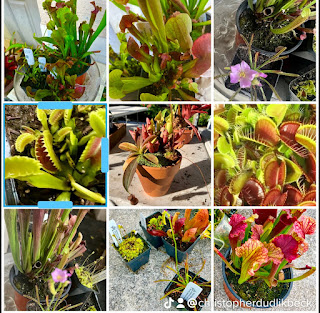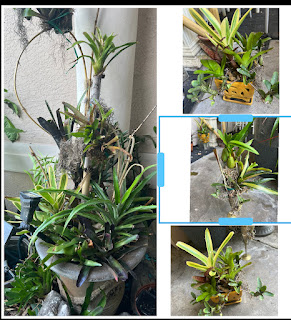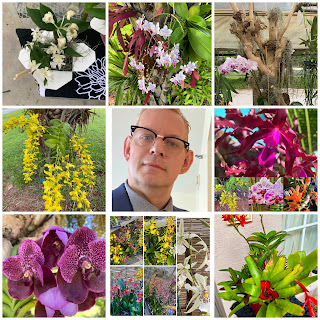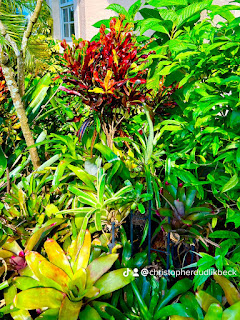There is asking all of my media sites and links available currently are in the right hand column of this blog
WHY I DO THIS BLOG ON RARE PLANTS
According to the report “State of the worlds plants”by researchers at the Royal Botanic Gardens, Kew, in the United Kingdom, there are about 391,000 species of vascular plants currently known to science. Of these, about 369,000 species (or 94 percent) are flowering plants.
By scanning through several plant databases, including the the Plant List, the International Plant Names Index and the World Checklist of Selected Plant Families, the team found that 391,000 vascular plants are currently known to science. Moreover, about 2,000 new plant species are discovered or described every year. Many of these newly described are already on The endangered list
#plantaddict #rareplant
#plantgeek
I’m coming back
 This is the official announcement. I’ll be returning to posting on all of my sites .. with rare posts on Facebook now and then.(It’s just not my best audiencen lol. more news to follow and a comprehensive list of what sites I’m on.y
This is the official announcement. I’ll be returning to posting on all of my sites .. with rare posts on Facebook now and then.(It’s just not my best audiencen lol. more news to follow and a comprehensive list of what sites I’m on.yThis is the official announcement. I’ll be returning to posting on all of my sites .. with rare posts on Facebook now and then.(It’s just not my best audiencen lol. more news to follow and a comprehensive list of what sites I’m on.y
#love
gay #instagay #lgbt #gayboy #pride #lgbtq #love #gayman #gaypride #loveislove #gaymen #queer #gayguy #gaylife #gaylove #bisexual #like #follow #instagood #gayhot #gayfollow
#pride
#gay #instagay #lgbt #gayboy #pride #lgbtq #love #gayman #gaypride #loveislove #gaymen #queer #gayguy #gaylife #gaylove #bisexual #like #follow #instagood #gayhot
Collage a whole one folder on my phone
CRISPR Pros and cons
The pros and cons of CRISPR Technology and Its Impact on Horticulture.
Introduction(the pros)
CRISPR technology is a new gene-editing tool that has revolutionized the field of horticulture. The technology has made it possible for breeders to create crops with desirable traits, without the need for traditional breeding methods like hybridization or selection. This paper seeks to explore what the new CRISPR technology is, how it works, and its impact on amateur hobbyists interested in horticulture.
What is CRISPR Technology?
CRISPR (Clustered Regularly Interspaced Short Palindromic Repeats) is a genetic tool that enables scientists to make precise cuts in DNA strands. It works by using a guided RNA molecule to identify and cut out specific sequences of DNA. The cut can then be repaired with a new DNA strand, creating a desired genetic change. CRISPR technology is a significant breakthrough because it is more efficient than previous gene editing tools like TALENs and Zinc-finger nucleases. This means that it is possible to edit genes faster, cheaper, and with more precision.
What are the uses of CRISPR technology in horticulture?
CRISPR technology has numerous applications in horticulture. For instance, it can be used to enhance crop yield by creating crops that are resistant to diseases, pests, and drought. It can also improve crop quality by changing the taste, color, and texture of fruits and vegetables. Additionally, CRISPR technology can be used to create new crops that are adapted to specific environmental conditions.
What does the CRISPR technology mean to the amateur hobbyist interested in horticulture?
.
Besides, CRISPR technology makes it possible to create crops that are adapted to local conditions. This means that amateur hobbyists can create crops that are suited to their specific climate zone, soil type, or environmental conditions. This capability allows for greater flexibility in gardening and can lead to more extensive crop choices.
Conclusion
In conclusion, CRISPR technology represents a significant breakthrough in gene editing, and its impact on horticulture is enormous. The technology has made it possible to create crops with desirable traits that are adapted to specific conditions. Hence, amateur hobbyists interested in horticulture can use the technology to create their desired plants, even without extensive scientific expertise. While the technology is still shrouded in controversy, its potential for improving crop yield, quality, and resilience cannot be ignored. Positive
CRISPR technology is a powerful tool that has revolutionized the field of genetic engineering. Although the applications of CRISPR are promising, there are potential risks associated with its use, especially in the hands of amateur hobbyists. There are examples of hobbyists conducting experiments outside of proper facilities with minimal knowledge of the technology, which pose a significant risk to public health and safety. This paper focuses on why amateur hobbyists should not play with CRISPR and the potential consequences of such actions.
But…. Great cautions should be exerted as to the access and use.
The very dangerous cons
Clustered Regularly Interspaced Short Palindromic Repeats (CRISPR) are a set of genetic tools that enable precise editing of DNA. CRISPR technology has already been used in agriculture, medicine, and scientific research. In recent years, the technology has become accessible to amateur hobbyists who can purchase cheap kits online.
Although the availability of CRISPR kits has opened up the potential for more people to experiment with genetic engineering, it has also raised concerns about the potential for misuse of the technology. Amateur hobbyists may not understand the risks and dangers associated with CRISPR technology, which could have serious consequences.
The CRISPR technology has many implications for amateur hobbyists interested in horticulture. For starters, it is now possible for hobbyists to create their desired crop varieties with desirable characteristics like flavor, disease resistance, and size. This means that amateur hobbyists can now create unique fruits and vegetables that are tailored to their specific needs
However
The Potential Consequences of Amateur Hobbyists Using CRISPR are numerous
One of the potential risks of amateur hobbyists using CRISPR is the accidental release of genetically modified organisms (GMOs) into the environment. Hobbyists may not have the facilities, expertise, or knowledge to safely contain the organisms that they are working with, leading to the risk of cross-contamination.
Another potential consequence of hobbyist experimentation with CRISPR is the production of dangerous mutations. Even minor errors in the genetic code can have serious consequences. Hobbyists may lack the knowledge and expertise to identify and mitigate these risks, leading to unintended health consequences.
Finally, the use of CRISPR by amateur hobbyists could lead to an increase in bio-terrorism. It is possible that terrorists could obtain CRISPR kits and use them for malicious purposes, such as creating a virus that would target specific populations.
Conclusion
In conclusion, there are several potential risks associated with amateur hobbyist experimentation with CRISPR. The risks include the accidental release of GMOs into the environment, the production of dangerous mutations, and the possibility of CRISPR being used for malicious purposes. Therefore, it is important to regulate and monitor the use of CRISPR technology, especially by amateur users. Hobbyists should not play with CRISPR until they have proper training, facilities, and safeguards in place to ensure the safety of themselves and others. The bottom line is that genetic engineering is not a job for amateur hobbyists, and the potential risks associated with the use of CRISPR technology cannot be underestimated.
MORE RARE TROPICAL PLANTS: Coffee, anyone???
Coffee, anyone???
Went out to trim my enormous coffee tree, but… Whoops this is what I found..
It looks to be a bumper crop this year probably one and a half pounds… I save it for a very rare occasions…(like when my eccentric, brilliant worldly ,rare plant friends visit)
Maybe I’ll do a presentation on the preparation of the beans and you know you can even grow it indoors like a house plant although you have to pollinate it yourself if you do that.
Like my fellow #plantgeek and #plantaddict (s) haven’t already used the paint brush trick.
Lol I invented the #Plantgeek… check my Twitter profile
Using coconut water as a plant hormone
Using coconut water for endospermic seed germination..and rooting hormone.
Introduction
Seed germination is an essential stage for plant growth and development, as it is the point where the seed transforms from its dormant state to an active seedling. Factors such as soil moisture, temperature, light, and nutrients play critical roles in this process. Recently, there has been growing interest in the use of organic substances, such as coconut water, in seed germination. This paper will explore the effects of coconut water on seed germination and plant growth.
Coconut Water Composition and Nutritional Properties
Coconut water is the liquid inside a green coconut, which is rich in nutrients such as vitamins, minerals, and amino acids. It has been found to contain cytokinins, auxins, and gibberellins. Cytokinins help cells divide and promote leaf growth. Auxins regulate plant growth and stimulate the formation of adventitious roots. Gibberellins promote stem elongation and flower development.
Coconut Water in Seed Germination
The use of coconut water in seed germination has been a subject of research and discussion for some time. Studies have shown that coconut water promotes seed germination, enhances root growth, and increases plant vigor. The cytokinins in coconut water stimulate cell division and promote the development of cotyledon and hypocotyl in the germinating seed. The auxins found in coconut water aid in the development of the primary root and lateral roots.
Research has also found that coconut water has a positive effect on seedling vigor. A study conducted by Kaur et al. (2012) found that the use of coconut water in seed germination resulted in the growth of a more extensive root system, thicker hypocotyl, and larger cotyledons compared to the control group.
Coconut Water in Plant Growth
Coconut water has also been found to have a positive impact on plant growth. Research indicates that the use of coconut water as a foliar spray in plant growth promotes better nutrient uptake, resulting in thicker, greener leaves and increased plant height. A study conducted by Mendez et al. (2019) in strawberry plants found that the use of coconut water as a foliar spray resulted in bigger and heavier fruits.
Proper Use of Coconut Water
Although coconut water has been found to be beneficial in seed germination and plant growth, it is vital to use it correctly. The potency of coconut water varies as it is sourced from different coconut varieties, and the stage at which it is harvested, so it is important to ensure that the coconut water is fresh and of good quality. A study conducted by Hossain and Rahman (2011) found that fresh coconut water yielded better results than coconut water stored for extended periods.
Conclusion
Coconut water is an excellent organic substance that has been found to promote seed germination, enhance root growth, and increase plant vigor. The cytokinins, auxins, and gibberellins present in coconut water provide the necessary nutrition for the seedling to develop, leading to better-quality crops. However, proper use of coconut water is necessary for optimal results. Further research is necessary to understand the best practices for the use of coconut water in seed germination and plant growth for different crop types.
References
Hossain, M. M., & Rahman, M. M. (2011). Adventitious rooting in tissue-cultured seedlings of sorghum: Its significance and ways of optimization. Plant Cell Reports, 30(5), 741-749.
Kaur, G., Asthir, B., & Bains, T. S. (2012). Coconut water priming improves seed germination and seedling vigour in mungbean (Vigna radiata L. Wilczek). Legume Research-An International Journal, 35(4), 331-336.
Mendez, L. T., & Khatibi, P. A. (2019). Coconut Water Promotes Plant Growth and Fruit Quality in Strawberry (Fragaria ananassa) Plants. Journal of Plant Growth Regulation, 38(4), 1524-1534.
Rare, bromeliad planter
Three Aechmea recurvata
Three varieties are recognized:[1]
- Aechmea recurvata var. benrathii (Mez) Reitz - Santa Catarina
- Aechmea recurvata var. ortgiesii (Baker) Reitz - São Paulo
- Aechmea recurvata var. recurvata - most of species range
my invisible throne
Learn the Latin
Learn the Latin
The purpose of this paper is to explain why it is important to learn and use the botanical name of a plant instead of just relying on its common name. The common name of a plant can vary from region to region, making it difficult for researchers, scientists, and scholars to communicate accurately and efficiently about a particular plant. The botanical name, on the other hand, is a standardized and universal system that allows for consistent and precise identification and classification of plants. This paper will provide evidence and examples to support the use of botanical names in various contexts, including agriculture, horticulture, medicine, and conservation.
Introduction:
The use of botanical names for plants has been a widely accepted practice among botanists, horticulturists, gardeners, and other plant enthusiasts for centuries. However, many people still prefer to use common names to refer to plants because they are easier to remember and recognize. While this may be true in some contexts, the disadvantages of using common names far outweigh the benefits. This paper will argue that learning and using the botanical name of a plant is essential for accurate and efficient communication, avoiding confusion, and promoting scientific and academic research.
Botanical names vs. common names:
The botanical name of a plant consists of two parts: the genus name and the species name. For example, the botanical name for the apple tree is Malus domestica. The first word (i.e., Malus) represents the genus, and the second word (i.e., domestica) represents the species. The botanical name is always written in Latin and is a standardized system that is universally accepted among botanists, horticulturists, and other plant experts.
In contrast, common names are based on local, cultural, or historical associations and can vary from region to region. For example, the apple tree may be called different names in different parts of the world, such as "manzana" in Spanish, "pomme" in French, or "ringo" in Japanese. Moreover, the same common name may refer to different plant species in different regions.
The importance of using botanical names:
Using botanical names is important for several reasons. Firstly, it allows for accurate and efficient communication among plant experts. Botanical names are standardized and universally accepted, which means that they can be easily understood and recognized by people from different countries and cultures. This is crucial for scientific and academic research, where accuracy and consistency are paramount.
Secondly, using botanical names helps to avoid confusion and errors. Common names can be misleading or vague, leading to misidentification or confusion with other plants. For example, the common name "redwood" may refer to different plant species in different regions, such as Sequoia sempervirens in California or Metasequoia glyptostroboides in China. Using the botanical name ensures that there is no ambiguity or confusion about the identity of a plant.
Finally, using botanical names helps to promote conservation and sustainability. Many plant species are endangered, and their conservation depends on accurate identification and classification. Using common names can create confusion and make it difficult to track and monitor plant populations. By using the botanical name, experts can accurately identify and track rare, threatened, or endangered plant species, and take appropriate conservation measures.
Conclusion:
In conclusion, learning and using the botanical name of a plant is essential for accurate and efficient communication, avoiding confusion, and promoting scientific and academic research. While common names may be easier to remember and recognize, they are not reliable or consistent, and they can vary from region to region. Botanical names, on the other hand, are standardized and universally accepted, and they provide a precise and accurate way to identify and classify plants. As plant conservation and sustainability become increasingly important, the use of botanical names is more crucial than ever to protect and preserve our planet's biodiversity.
Almost Unkillable plant species for those who are plant challenged
Plant species for plant killers… they are almost impossible to kill… the plants …not the people lol
found some tough plant species that are almost impossible to kill. I’ve listed them under the common names because they are for plant beginners.
1. Snake plant: This plant is almost indestructible and can thrive in almost any conditions, including low light and minimal water.
2. ZZ Plant: This is another species that can survive in low light and is practically impossible to kill.
3. Pothos: Pothos can tolerate low light and infrequent watering, making them great for beginners.
4. Aloe Vera: This plant can survive long periods without water and is also known for its medicinal properties.
5. Spider Plant: Spider plants are very adaptable to different environments, including low light and high humidity.
6. Jade Plant: Jade plants can tolerate neglect and lack of water for extended periods of time, but they do require occasional watering.
7. Peace Lily: Peace lilies are one of the easiest plants to care for and can survive in low light and dry conditions.
8. Rubber Plant: Rubber plants are resilient and can withstand a variety of conditions, including low light and periods of drought.
9. Cactus: Cacti are well-known for their ability to survive in harsh desert environments and require minimal watering.
10. Succulents: Succulents are hardy plants that can survive in drought-like conditions, making them ideal for those who forget to water their plants.
Warning, most of these are toxic (to children and pets)… But I figured if you can’t keep our plant alive… Lol
13 fragrant tillandsias
fragrant tillandsia species:
- Tillandsia albertiana
- Tillandsia aromatica
- Tillandsia cyanea
- Tillandsia duratii
- Tillandsia fasciculata
- Tillandsia gardneri
- Tillandsia ionantha
- Tillandsia juncea
- Tillandsia kautskyi
- Tillandsia odorata
- Tillandsia streptophylla
- Tillandsia tectorum
- Tillandsia usneoides
The best Clerodendron
Clerodendrum wallichii, also known as Harlequin Glorybower or Bleeding-heart Clerodendrum, is a deciduous shrub belonging to the family Lamiaceae. It is native to the Himalayas, from Pakistan to Nepal, Bhutan, and China. The plant prefers warm temperate to subtropical climates and grows well in well-drained soils with moderate moisture levels.
Clerodendrum wallichii grows up to 3 meters in height and has an upright branching habit with large, ovate leaves that can grow up to 25 cm long. The flowers are tubular, white, and pink, with showy crimson calyces, and can bloom from early summer to fall. The berries of this plant are also showy, bright red with purple spots and contain small seeds.
The plant has been used for ornamental purposes and traditional medicine, and the roots, stem, leaves, and flowers are all used in Ayurvedic medicine to treat various ailments like fever, dysentery, and skin infections. The plant is also known to possess anti-inflammatory and anti-diabetic properties.
Clerodendrum wallichii is a popular ornamental plant, prized for its attractive foliage, and showy flowers which are commonly used in cut flower arrangements. It is easy to propagate by stem cuttings or layering and can be grown in containers as well. However, it is important to note that all parts of the plant are toxic if ingested and should be kept out of reach of children and pets.
#photoftheday
Actually, it’s more like 20 photos of the day #viral #TikTok #Photooftheday #orchid
#rareplants #plantgeek #plantsofInstagram
#plantart #photography #Followme #bromeliad #trending #coolplant
My puppy is out of this world
Puppy invaded my life and brought me so much joy #doxie #dogsoftiktok #oddities #rareplants #followback #plantsoftiktok #bromeliads #repost #plantsofinstagram #odd #puppy #plantart #like
Bodacious, botanical beauties
Drool over these bodacious, botanical beauties
#plantart #plantaddict #plantgeek #like #repost #Follow #botany #horticulture #bromeliads #plantsofInstagram #odd #Oddities #plantart
Neoregelia
#epiphyte #Bromeliad
#botany #oddities #plantaddict #plantgeek #horticulture #coolplants #plantsofInstagram
Don’t watch
#epiphyte #Bromeliad #neoregelia #photooftheday
#instagood #trending
#botany #Oddities #Follow #plantgeek #horticulture #coolplant #plantsofInstagram
How to sterilize Spanish moss, but not kill it
This video is so popular on my other sites that I thought I’d post it
5 fantastic herbs for butterflies
Five fragrant herbs that are also butterfly plants
#botany #oddities #plantaddict #plantgeek #horticulture #coolplants #plantsofInstagram #herbal #butterfly #unique #eccentric






















































